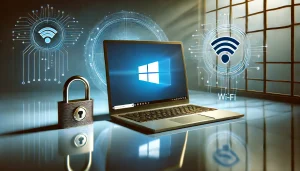Protect Your PC: Critical Wi-Fi Vulnerability in Windows Fixed
In a recent security scare, a significant Wi-Fi Vulnerability was uncovered in the Windows Wi-Fi driver, putting millions of users at risk. This vulnerability, identified as CVE-2024-30078, allowed malicious actors to exploit the Wi-Fi driver to execute harmful programs on affected computers. It impacted all modern versions of Windows and Windows Server, posing a severe threat to users worldwide. Fortunately, Microsoft has swiftly addressed this Wi-Fi Vulnerability with a security update, but understanding the risks and taking proactive steps to protect your system in the future is essential.
Understanding the Wi-Fi Vulnerability
Microsoft assigned a severity rating of 8.8 to this Wi-Fi Vulnerability, indicating a high level of risk. This “Windows Wi-Fi Driver Remote Code Execution Vulnerability” enabled attackers within Wi-Fi range to send specially crafted network packets to target computers, executing malicious code without user interaction or special permissions. The ease with which this Wi-Fi Vulnerability could be exploited made it an especially potent threat.
To illustrate the danger, imagine using your laptop at a cafe, confidently connected to a public Wi-Fi network. With this Wi-Fi Vulnerability, a hacker could silently install malware on your device without requiring you to click on anything. The vulnerability was particularly dangerous in public spaces such as hotels, airports, and cafes, where many people connect to Wi-Fi networks. Although no active exploits were reported before the patch was released, the ease of exploitation made this Wi-Fi Vulnerability a ticking time bomb for users worldwide.
According to Microsoft’s advisory, for the exploit to succeed, the attacker must be connected to the same network as the vulnerable device and capable of sending and receiving radio transmissions. This means that not only public networks but also private networks are at risk if a malicious actor gains access. This broad scope of potential exposure makes the Wi-Fi Vulnerability even more concerning, highlighting the need for vigilance in both public and private network environments.
Microsoft’s Response
On June 11, 2024, Microsoft rolled out a comprehensive patch that addressed this critical vulnerability alongside fixes for 49 other CVEs (Common Vulnerabilities and Exposures) across various Windows components, including Office, Azure Dynamic Business Central, and Visual Studio. For users running supported Windows versions, this update is vital to safeguarding their systems against potential exploits. Users operating on unsupported Windows versions are strongly advised to upgrade immediately to receive these critical updates.
Microsoft’s quick response underscores its commitment to user security. However, it also serves as a reminder that users must remain proactive. Relying solely on automatic updates may not always suffice. Users should ensure their systems are configured to receive updates promptly and verify that these updates have been successfully installed.
Essential Patching Steps to Secure Your System
Proper patching is one of the most effective defenses against such vulnerabilities. Here’s a detailed guide on how to ensure your Windows system is fully protected through regular updates:
For Windows 10 and Windows 11:
- Access the Settings: Click on the Start menu and select “Settings” or press the Windows key + I.
- Navigate to Update & Security: In the Settings window, go to “Update & Security.”
- Check for Updates: Click on “Check for updates.” The system will search for available updates.
- Install Updates: If updates are available, they will be downloaded and installed automatically. Follow any prompts to restart your computer.
For Windows 8.1 and Earlier Versions:
- Open Control Panel: Navigate to the Control Panel and select “System and Security.”
- Check for Updates: Click on “Check for updates” to see if there are any available updates.
- Install Updates: Select the available updates and click “Install updates.” Follow the on-screen instructions and restart your computer if prompted.
By regularly updating your Windows software, you protect yourself from the recently discovered Wi-Fi driver vulnerability and ensure your system is fortified against other known security threats. Software updates are not just about new features; they are critical to maintaining a secure and reliable computing environment. Cybercriminals constantly seek new vulnerabilities to exploit, making it crucial to stay vigilant and install updates as soon as they become available.
Best Practices to Avoid Wi-Fi Cyberattacks
Beyond patching, several best practices can further protect you from potential Wi-Fi cyberattacks. Implement these six essential tips to enhance your security:
- Enable Strong Encryption: Ensure your network uses WPA2 or WPA3 encryption, and avoid outdated WEP security. Encryption adds a significant layer of security by making it difficult for unauthorized users to access your network. Your router’s manual will guide you on how to enable these settings.
- Update Wi-Fi Password Regularly: Change the default router name and password upon setup and update them regularly. A strong, unique password can prevent unauthorized access and make it more difficult for hackers to infiltrate your network.
- Keep Firmware and Software Updated: Regularly update your router firmware and computer software to guard against security threats. Manufacturers release updates to patch vulnerabilities, and staying current with these updates is crucial for maintaining security.
- Install Robust Antivirus Software: Protect your devices from malware by using reliable antivirus programs. Antivirus software can detect and block malicious activities, providing an additional layer of defense against cyber threats.
- Choose a Secure Router: Invest in a router known for its robust security features and compatibility with VPNs. Modern routers come with advanced security settings and are designed to offer better protection against cyber threats.
- Use a VPN: Enhance your security with a Virtual Private Network, especially when accessing your network remotely. A VPN encrypts your internet traffic, making it difficult for hackers to intercept your data.
Additionally, educating yourself and your household members about safe internet practices can go a long way in preventing cyberattacks. Avoiding suspicious links, being cautious about sharing personal information, and regularly monitoring your network for unusual activity are good habits to cultivate.
Technical Analysis of the Vulnerability
From a technical standpoint, this vulnerability is particularly concerning because it does not require any special conditions to exploit. The threat actor only needs to be on the same network as the target device and can send malicious network packets to the Wi-Fi adapter, making the vulnerability extremely easy to exploit and potentially very dangerous.
The affected Microsoft products include various versions of Windows 10, Windows 11, and Windows Server, indicating a widespread impact. Although no public exploit is currently available, the possibility of developing a functional reproduction means that threat actors could soon target this vulnerability, underscoring the need for prompt patching and vigilance.
Conclusion
The discovery of the Windows Wi-Fi driver vulnerability serves as a stark reminder of the importance of regular software updates and robust security practices. While Microsoft has patched this critical flaw, ensuring your system remains secure requires ongoing diligence. By updating your software promptly and adhering to best practices, you can protect your devices from potential cyber threats and enjoy a safer online experience.
In a world where cyber threats are constantly evolving, staying informed and proactive is your best defense. Protect your digital life by keeping your software updated, using strong security measures, and being vigilant about your online activities. Your efforts today can safeguard your data and privacy for the future.







